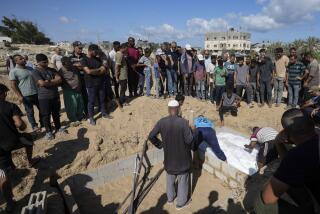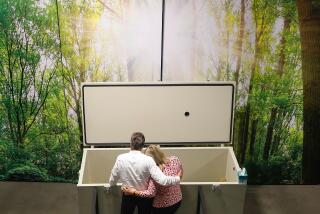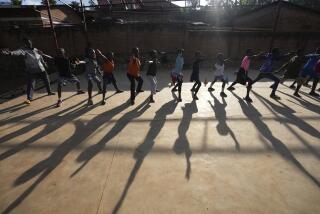After quake, Japanese grapple with honoring the dead they can’t see
- Share via
Reporting from Miyako, Japan — Shoichi Nakamura is having trouble sleeping and eating. Her brother, sister-in-law and their child have been missing for more than a week. She’s been to three evacuation centers and pored over countless lists at disaster centers.
That’s left her with a dilemma she shares with a growing number of Japanese in the wake of the March 11 earthquake and tsunami: When do you give up hope that your relatives are alive? And how do you mark a death in tradition-bound Japan without a body to cremate?
“I think the tsunami took my brother,” said Nakamura, 58, who works at a cleaning service, her voice barely audible as she huddled on a blanket among other evacuees in the Yamaguchi Elementary School gym, her slippers placed neatly on the edge. “But another part of me doesn’t want to give up searching. I’m sick wondering what to do.”
The official toll of dead and missing exceeds 21,000, leaving ruined seaside communities in the Tohoku region struggling to ensure that the dead are treated with dignity amid a shortage of nearly everything needed to hold a funeral. Gymnasiums, schools and even bowling alleys have become makeshift morgues for the bodies that have been recovered.
Given the circumstances, the Health Ministry said last week that it would waive the rules requiring relatives to obtain local permission before carrying out burials or cremations.
As time goes on, there will be more and more services without bodies.
The lack of a body makes it difficult to have a proper osoushiki, or funeral ceremony, Nakamura said. Instead of using the remains of her brother and his family, she may have to use another family’s bone chips or ashes as a stand-in. The Buddhist priests have declared that an acceptable alternative, she said.
“I hear city hall may give them out,” she said.
Other options include collective ceremonies known as godousou, or cremation of the clothes, photographs or personal items of the deceased in lieu of a body. Even a pinch of dirt from the spot the dead were last seen may have to do.
“Many people will have to do this,” said Souichiro Tachibana, 50, a teacher at an evacuation center in Miyako. “Even though it may not be your exact relation, what’s important is to believe it is, for peace of mind. This is the last choice, but what can you do?”
Japan did something similar during World War II when large numbers of Japanese troops died overseas. The government would distribute sticks to the grieving families, saying they were from the war zone, said Shinya Yamada, assistant professor at Tokyo’s National Museum of Japanese History. “But who knows if it’s true,” he said.
Each family must decide when to give up hope. If the fishing industry is any guide, most people will decide within a week or two, said Takeshi Asada, 64, a boat engine mechanic who was wandering amid Miyako’s beached vessels, tangled nets and floats in search of a neighbor’s husband.
“When bodies are taken by a tsunami or sea accident, they decompose and float onto the beach,” he said. “If nothing shows up in a week or two, people accept the inevitable.”
Driven by limited space and government nudging, the percentage of Japanese who are cremated has grown steadily, reaching 99% in 2009.
Cremation is also considered a purification rite before the next life. Some people interviewed by Japanese news media over the last week said they faced a life of despair if they didn’t find their relatives’ bodies. Others fear their loved ones’ spirits will haunt them without a proper burial.
“Indeed, some people believe ghosts of the dead killed violently that are not cared for can cause problems,” said Ian Reader, professor of Japanese studies at Britain’s University of Manchester. “And places like Tohoku, with an aged population and a more ‘traditional’ orientation than, say, Tokyo, might hold to such views more strongly.”
But cremation requires 10 or more gallons of kerosene, which is in short supply, and some local governments have started burying the dead, an option some consider unclean.
A further complication is that many of those grieving have no place to store an urn containing a loved one’s ashes. “We’re trying to preserve their memories,” said Wataru Takahashi, 36, whose cousins, a mother-in-law and a sister-in-law are missing. “But we need a house first.”
Some say kerosene should be used for the dead even if it leaves the living cold and hungry.
“I’ll do what it takes to get the fuel, and I don’t care if they say I’m a bad guy,” said Bunkai Abe, chief priest of the Jouan Temple in Miyako, which was relocated in 1618 up a steep road from the port after being flattened by a tsunami.
At the Ruisen Temple in neighboring Yamada, a town that has recovered 379 bodies, priest Keizan Ishigamori said some burial is probably inevitable. The community’s crematorium can handle only nine bodies a day.
“Being buried or burned isn’t about religion,” Ishigamori said. “It’s more about culture and ceremony. The soul starts its voyage either way.”
Priests said troubled survivors have many questions. “They want to cry; they’re angry,” Ishigamori said. “But they’re holding it inside. It’s terrible. But it happened, and we must help each other to move on.”
Special correspondent Kenji Hall in Tokyo contributed to this report.
More to Read
Sign up for Essential California
The most important California stories and recommendations in your inbox every morning.
You may occasionally receive promotional content from the Los Angeles Times.










